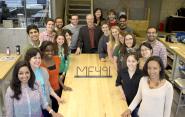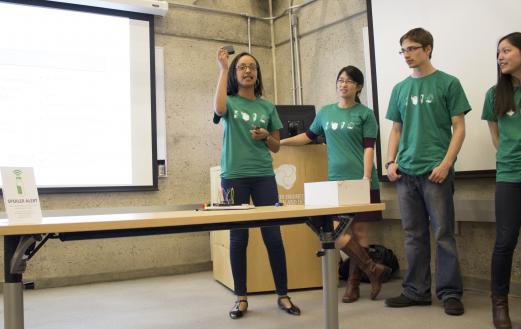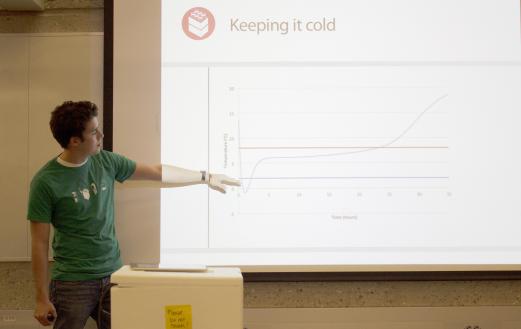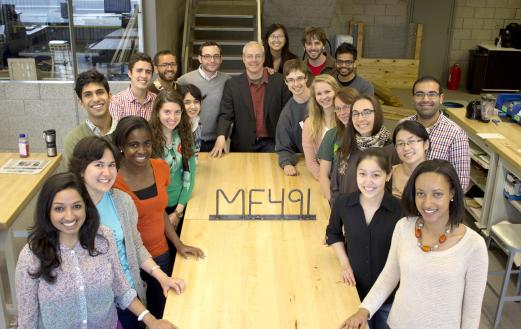MENG 491 Students Innovate Vaccination Delivery

Fifteen weeks ago, students enrolled in “MENG 491: Appropriate Technology in the Developing World” were given some daunting homework: do something to help the 1.5 million people who die each year from vaccine-preventable diseases.
“In the West, vaccines are very easy to get, and every one of you, by the time you were four years old, probably had twenty of them,” said Bo Hopkins, a lecturer at the Jackson Institute for Global Affairs and co-instructor of the course. “But for different parts of the world—where electricity is absent yet the need for it is not—it gets very complicated. A vaccine has to stay between two and eight degrees Celsius, even as it travels overseas from a manufacturer to a central repository, from the repository to a regional clinic. And then it winds its way through what we call ‘The Last Mile.’”
The Last Mile, which might be much longer or shorter than an actual mile, refers to the last leg of the vaccine’s journey, and it is often the most logistically complex element of vaccine delivery. Vaccine carriers may have to traverse rough terrain with no roads, and the ultimate delivery point may lack the electricity needed to keep the vaccines cold. After the vaccines arrive, clinicians face organizational and cultural difficulties that can also prevent the right vaccine from reaching the right recipient.

To address these problems, the students generated hundreds of ideas and reached out to dozens of international partners. The ideas were the evaluated for desirability, feasibility, and viability.
“‘Desirability’ is essentially what people want and need. ‘Feasibility’ is whether we can create the technology to make this thing real. And ‘viability’ has to do with the sustainability of this idea in terms of deploying it and developing a business around it,” said Joe Zinter, assistant director of the Center for Engineering Innovation and Design, and the other co-instructor for the course. “Four ideas met those criteria and were developed from concept to prototype, and now these teams are ready to think about how the next level of deployment would happen.”
Keeping Cool in Hot Temperatures
The four projects presented to the public on April 24 each addressed a specific component of the vaccine delivery problem. “Spoiler Alert,” for example, is an active real-time temperature monitoring system small enough to fit inside the portable vaccine storage containers. If a container gets too hot or too cold for the vaccine to be effective, Spoiler Alert sends a text message identifying which container may have been spoiled along with the container’s GPS location. Additionally, the device begins beeping so that vaccine carrier or clinician can know immediately not to distribute the contents.
Spoiler Alert addresses the on-site problem of preventing ineffective vaccines from being distributed. As well, the spoilage data is kept in a central database that can be aggregated by users to identify and address common spoilage areas. For example, if vaccines were routinely spoiling en route to one location, vaccine carriers might choose a different distribution method. Alternatively, Spoiler Alert users could instead use better technology that could keep vaccines cool for a longer period of time. That’s where “Cool-It” comes in.

Cool-It is a modular packaging design that stays at the ideal vaccine temperature much longer than the more typical styrofoam containers and ice packs. Using what’s known as “phase-change material” (PCM), the packaging can store and release high amounts of energy, enabling it to remain at the ideal temperature for up to 33 hours, a 50% improvement over the 22 hours accomplishable with just styrofoam and ice.
Additionally, while greater heat resistance is the obvious benefit of using Cool-It, the product also has the significant benefit of resisting very cold temperatures as well. Without PCM, the sub-zero ice packs placed next to the vaccine vials can cause the vaccines to freeze, which is just as harmful as too much heat. Cool-It absorbs this cold, preventing the possibility of freezing.
Large Solutions in Small Packages
The third project, “Thermoject,” is an integrated system that rethinks not only how vaccines are transported, but also how they are administered to the patient. Instead of separate vaccine vials, syringes, and needles, Thermoject is a pre-dosed single-use vaccine administrator that resembles a small tube of superglue, but with a capped needle on the end instead of an application nozzle and with only two sides being soft enough to squeeze.
Thermoject “syringes” are stored in a high-capacity thermal sleeve that, like Cool-It, uses PCM to keep the vaccines cold. The thermal sleeve is shaped like a triangular prism, and it allows fresh syringes to be removed from one end and used syringes to be loaded into the other end for disposal. Notably, this design enables clinicians to easily transport more than 300 vaccine doses in a standard backpack, with no worries that a vital component might be left behind. As well, unlike the currently-used needles and syringes, Thermojects can be just as easily and hygienically transported back from site visit using the thermal sleeve.

While Thermoject rethinks the vaccine supply chain from creation to delivery, “Khushi Baby” addresses the huge organizational difficulties faced by both clinicians and mothers as they track a child’s vaccination record. The team’s product, which translates as “Happy Baby,” takes the standard silicone bracelet made popular by the LiveStrong Foundation and combines it with the same near-field communication chips used in college ID cards. The inexpensive result, which is waterproof and color customizable, allows infants to wear their entire vaccination record around their wrists, eliminating the need for mothers to keep a paper record that can be accidentally lost or destroyed.
The communication chip also results in significant improvements for data that the clinicians need, such as making it possible to retrieve and update the infant’s digital record using just a smartphone. As well, because Khushi Baby’s data is kept in the cloud, the vaccination data for an entire region can be aggregated in real-time, enabling healthcare workers and vaccine suppliers to forecast vaccination demand and ship appropriate supplies to each delivery point on time.
Ready to Deploy
Like all the teams, Khushi Baby’s members are a diverse group, with backgrounds in molecular biology, economics, chemistry, and management. From 50 applicants, the class of 16 represents a cross-section of Yale collaborators, with each team member bringing a unique expertise to help address what Zinter called “a very complicated problem.” In addition to their invention, each group also produced an outline of next steps, suggesting where they might begin field testing their innovations before ultimate deployment as real-world solutions to this real-world problem.
“This class is a tremendous learning opportunity, and every one of these projects is capable of moving out of the lab and into a space where the next level of deployment would happen,” said Hopkins. “And that’s a big piece of this class—how do we get out of the lab once we develop our ideas. All of these things are means for us to get our ideas moving forward, and it’s not just limited to the classroom experience.”

